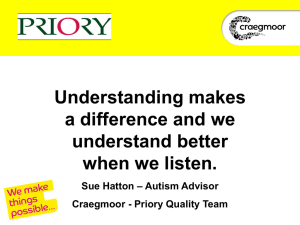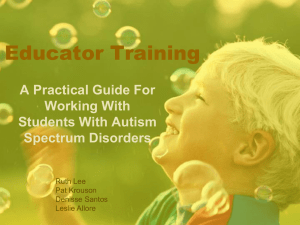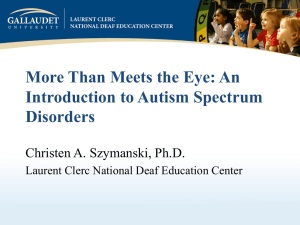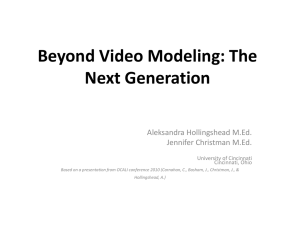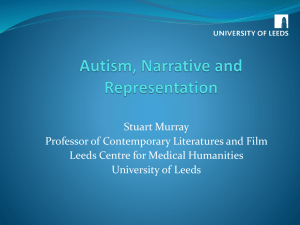Managing the Healthcare Needs of Adolescents with ASD: A
advertisement
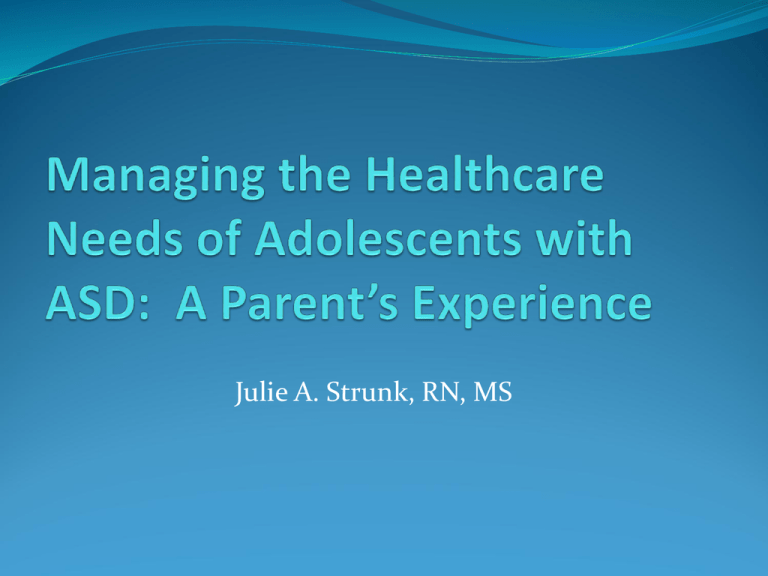
Julie A. Strunk, RN, MS Study Aim To examine the parent’s experience of managing the healthcare needs of the adolescent with Autism Spectrum Disorder (ASD). Significance of Study CDC’s declaration on autism Fastest growing developmental disorder Affects 1 out of 150 children Third most common childhood disorder Prevalence rate increasing by 10-17% annually Autism Society of America Occurs more frequently than childhood cancer, cystic fibrosis, and multiple sclerosis Study Design Phenomenological Qualitative Study Ontology Epistemology Background of Problem Findings from literature review Affects on family Increased healthcare needs Autism Spectrum Disorder Definition Signs and Symptoms Diagnosis Treatment Data Collection Participants IRB approval (VCU and JMU) Informed consent Interview Sample questions Storage of data Data Analysis Moustakas's method of analysis with phenomenological data Epoche Bracketing Horizontalization (significant statements) Invariant qualities and themes (meaning units/themes) Imaginative variation (textural/structural descriptions) Essence Trustworthiness Prolonged engagement Peer debriefing Member checking Transferability Demographics Participant Child’s Age (years) Child’s Gender Level of Function Mother 11 Boy High functioning Mother 10 and 12 Boys 10-year-old: Severe 12-year-old: High functioning Mother 18 Boy High functioning Father and mother 18 Girl Severe Father and mother 13 Boy High functioning Mother 18 Boy Severe Mother 12 Girl High functioning Mother 12 Boy High functioning Mother 13 Girl High functioning Mother 11 Boy High functioning Findings The essence of the phenomenon was parents needing help in order to meet the healthcare needs of their adolescents with ASD. Four main themes Concerns about Medications Frustration with Healthcare Services Recognizing Secondary Health Issues Need for Specific Resources Findings Concerns about Medications Numbers and types of medications Side effects Administration problems Role of pharmaceutical companies “It’s very frustrating for me because he’s on an enormous amount of medication.” “I want to know the side effects. I want to know if this is this going to make him sterile, or if it will affect his liver or his heart.” “I read those medical warnings about suicidal risk and all that kind of stuff and it just sets me in a panic.” “He just wants to be like the other kids so he quit taking his meds.” “I’m kind of conflicted because I don’t want to overmedicate my child, however, if the medication is going to help him and if it’s something that’s going to be very beneficial to him, then I’m all for it.” “I don’t know what [role] the drug companies play in all of this but I’m sure that there’s more pressure for people to try drugs that maybe they shouldn’t be trying.” Findings Frustration with Healthcare Services Lack of knowledge Type of immediate care received Perception of parents Treatment of adolescent “I felt like I had to educate the doctors regarding my son’s autism.” “It was very frustrating for me to have a doctor who sees her but doesn’t really know her, to look at her chart and state that she’s all drama and not take the moment as being legitimate for what it is.” “I just got frustrated with the whole medical community, kind of feeling like they were blowing me off and were not just helping me so I kind of stopped going down that road.” “Some doctors acted like we were just totally stupid and would not listen.” “I’ve taken my son to a doctor who really didn’t know how to deal with him, so we couldn’t go back.” Findings Recognizing Secondary Health Issues Seizures, constipation and diarrhea, celiac disease, and lactose intolerance Personal hygiene, sleep, and safety Hormonal changes Risky behaviors Intolerance of medical procedures “She’s not only autistic, she’s epileptic and it is time consuming with that, and so with taking care of all her medical needs I had to quit work.” “Sleep is probably the biggest stressor.” “I have to really stay on him about brushing his teeth and taking a shower. We have to make sure that he’s using soap on his whole body.” “He’ll just wander around the yard at night and you’ll just see him looking in our window.” “He’s a huge safety risk; he doesn’t understand safety or the concepts of safety. He doesn’t understand that if he stands in the road flapping his hands he could get hit by a car and die.” “Somebody dared my son to snort a whole pill of OxyContin and he did and it almost killed him.” “It’s very difficult to take him to the doctor’s office because he is so hard to manage. “It often takes several people to hold him down if he needs an injection.” Findings Need for Specific Resources Lack of services Lack of resources Lack of assistance Need for more and better education “I wish there were more services and that they [doctors] knew what to do.” “I don’t feel that there’s been enough in different areas in adolescents or in the younger ages to know how to adequately treat these children.” “I feel like I’m a fighter and I have to investigate it myself.” “We cannot do it without services or resources out in the community.” “You have to beg and ask for medical services. It’s not just somebody advertising that they’re doing this for autism.” Strengths Issues could be examined in detail and in depth. Interviews were not restricted to specific questions and could be guided/redirected by the researcher in real time. The data based on human experience that was obtained can be powerful and sometimes more compelling than quantitative data. Subtleties and complexities about the research subjects and/or topic were discovered could have been missed by more positivistic enquiries. Data that was collected from a few individuals so findings may not be appropriate to generalize to a larger population. Findings can however be transferable to another setting. Limitations Research quality was heavily dependent on the individual skills of the researcher and was more easily influenced by the researcher's personal biases and idiosyncrasies. The volume of data made analysis and interpretation time consuming. The researcher's presence during data gathering, which was unavoidable, could have affected the subjects' responses. Recommendations More studies are needed concerning medications currently prescribed for adolescents with ASD and particularly about medication effectiveness Thorough physical exams and assessments Use of behavior therapy in conjunction with medication administration Healthcare providers should provide advocacy Recommendations Parents and healthcare providers should partner to improve effectiveness of healthcare delivery Healthcare providers should increase their understanding of ASD Information is need for parents of adolescents with ASD Future Research Healthcare providers perceptions of managing the care of an ASD adolescent Student nurses – how much is being taught on low incidence disabilities Is there a correlation between the strong desire for carbs/sugar and obesity with ASD Is there a correlation between hormonal surge and escalation of violent behaviors Mothers adapting to their ASD child’s cues Is there a correlation between lead intake and ASD References Abbeduto, L., Seltzer, M.M., Shattuck, P., Krauss, M.W., Orsmond, G., & Murphy, M.M. (2004). Psychological well-being and coping in mothers of youths with autism, Down syndrome, or fragile X syndrome. American Journal of Mental Retardation, 109(3), 237-254. Aman, M.G., Lam, K.S.L., & Collier-Crespin, A. (2003). Prevalence and patterns of use of psychoactive medicines among individuals with autism in the Autism Society of Ohio. Journal of Autism and Developmental Disorders, 33(5), 527-534. Doi: 10.1023/A:1025883612879 Autism Society of American. (2009). About autism. Retrieved from http://www.autism-society.org/site/PageServer?pagename=about_home Bellando, J. & Lopez, M. (2009). The school nurse’s role in treatment of the student with autism. Journal for Specialists in Pediatric Nursing, 14(3), 173-182. Doi: 10.111/j.1744-6155.2009.00195x Beresford, B. A. (1994). Resources and strategies: how parents cope with the care of a disabled child. Journal of Childhood Psychology and Psychiatry, 35, 171–209. Birkan, B., Klantz, P.J., & McClannahan, L.E. (2010). Teaching children with Autism Spectrum Disorders to cooperate with injections. Research in Autism Spectrum Disorders, 5, 941-948. Doi: 10.1016/j.rasd.2010.11.004 Burke, L.M., Kalpakjian, C.Z., Smith, Y.R., & Quint, E.H. (2010). Gynecological issues of adolescents with Down syndrome, autism, and cerebral palsy. Journal of Pediatric Adolescent Gynecology, 23, 11-15. Canitano, R., Luchetti, A., & Zappella, M. (2005). Epilepsy, electroencephalographic abnormalities, and regression in children with autism. Journal of Child Neurology, 20, 27–31. Carpenter, P. (2009). Mental health aspects of Autism Spectrum Disorders. In A. Hassiotis, D.A. Barron, & I. Hall (Eds.), Intellectual disability psychiatry: A practical handbook. England: John Wiley & Sons Ltd. Centers for Disease Control and Prevention. (2010). Autism spectrum disorders (ASDs). Retrieved from http://www.cdc.gov/ncbddd/autism/index.html Cole, L. L. (2008). Autism in school-age children a complex collage of development, behavior and communication. Advance for Nurse Practitioners, 16, 38-47. Creswell, J. W. (1998). Qualitative Inquiry and Research Design; Choosing Among Five Traditions. London, New Delhi, Thousand Oaks, Sage Publications Creswell, J. W. (2007). Five qualitative approaches to inquiry. Qualitative inquiry & research design choosing among five approaches (2nd ed., pp. 85-100). Daniels, V. (2005). Lecture on phenomenology. Lecture presented at Sonoma University, Sonoma, CA. Finlayson, J., Morrison, J., Jackson, A., Mantry, D., & Cooper, S-A. (2010). Injuries, falls and accidents among adults with intellectual disabilities: Prospective cohort study. Journal of Intellectual Disability Research, 54(11), 966-980. Doi: 10.1111/j.13652788.2010.01319.x Frazier, T.W., Youngstrom, E.A., Haycook, T., Sinoff, A., Dimitriou, F., Knapp, J., & Sinclair, L. (2010). Effectiveness of medication combined with intensive behavioral intervention for reducing aggression in youth with Autism Spectrum Disorder. Journal of child and Adolescent Psychopharmacology, 20(3), 167-177. Doi: 10.1089/cap.2009.0048 Guba, E. G. (1981). Criteria for assessing the trustworthiness of naturalistic inquiries, Educational Communication and Technology Journal, 29 (2), 75-91. Hellemans, H., Colson, K., Verbracken, C., Vermeiren, R., & Deboutte, D. (2007). Sexual behavior in high-functioning male adolescents and young adults with Autism Spectrum Disorder. Journal of Autism and Developmental Disorders, 37, 260-269. Doi: 10.1007/s10803-006-0159-1 Hertz-Picciotto, I. & Delwiche, L. (2010). The rise in autism and the role of age at diagnosis. Epidemiology, 20(1), 84-90. Doi: 10.1097/EDE.0b013e3181902d15 Hoffman, C.D., Sweeney, D.P., Lopez-Wagner, M.C., Hodge, D., Nam, C.Y., & Botts, B.H. (2008). Children with autism: Sleep problems and mothers’ stress. Focus on Autism and Other Developmental Disabilities, 23(3), 155-165. Doi: 10.1177/1088357608316271 Howlin, P. & Moore, A. (1997). Diagnosis in autism: A survey of over 1200 patients in the UK. Autism, 1(2), 135-162. Honberg, L., Kogan, M., Allen, D., Strickland, B., & Newacheck, P. (2009). Progress in ensuring adequate health insurance for children with special health care needs. Pediatrics, 124(5), 1273-1280. Doi: 10.1542/peds.2009-0372 Huang, P., Kallan, M.J., O’Neil, J., Bull, M.J., Blum, N.J., & Durbin, D.R. (2009). Children with special healthcare needs: Patterns of safety restraint use, seating position, and risk of injury in motor vehicle crashes. Pediatrics, 123(2), 518-523. Doi: 10.1542/peds.2008-0092 Kakulu, I. I., Byrne, P., & Viitanen, K. (2009). Phenomenological research in compulsory land acquisition and compensation. In FIG working week. Retrieved from www.fig.net/pub/fig2009/papers/…/ts07e_kakulu_byrne_viitanen_3448.pdf King, M. & Bearman, P. (2009). Diagnostic change and the increased prevalence of autism. International Journal of Epidemiology, 38, 1224-34. Klein, J.D. & Wilson, K.M. (2002). Delivering quality care: adolescents’ discussion of health risks with their providers. Journal of Adolescent Health, 30(3), 190-195. Doi: 10.1016/S1054-139X(01)00342-1 Kogan, M.D., Strickland, B., Blumberg, S., Singh, G., Perrin, J., & van Dyck, P. (2008). A national profile of the health care experiences and family impact of autism spectrum disorder among children in the United States, 2005-2006. Pediatrics, 122(6), e1149-e1158. Doi: 10.1542/peds.2008.1057. Konstantareas, M., & Lunsky, Y. (1997). Sociosexual knowledge, experience, attitudes and interests of individuals with autistic disorder and developmental delay. Journal of Autism and Developmental Disorders, 27, 397-413. Lincoln, Y.S. & Guba, E.G. (1985). Naturalistic inquiry. Newbury Park, CA: Sage Publications. Lord, C. & Bishop, S. (2010). Autism spectrum disorders: Diagnosis, prevalence, and services for children and families. Social Policy Report Sharing child and Youth Development Knowledge, 24(2), 112. Luscre, D.M. & Center, D.B. (1996). Procedures for reducing dental fear in children with autism. Journal of Autism and Developmental Disabilities, 26, 547-556. Matson, J.L., Dempsey, T., & Fodstad, J.C. (2009). The effect of Autism Spectrum Disorders on adaptive independent living skills in adults with severe intellectual disability. Research in Developmental Disabilities, 30, 1203-1211. Doi: 10.1016/j.ridd.2009.04.001 Mitchell, G.J. & Cody, W.K. (1999). Nursing knowledge and human science: Ontological and epistemological considerations. In E. C. Polifroni & M. Welch (Eds.), Perspectives on philosophy of science in nursing an historical and contemporary anthology (202-213). Philadelphia, PA: Lippincott Williams & Wilkins. Moustakas, C. (1994). Phenomenological research methods. Thousand Oaks, CA: Sage. Mulligan, J., Steele, L., MacCullough, R., & Nicholas, D. Evaluation of an information resource for parents of children with Autism Spectrum Disorder. Autism, 14, 113-126. Doi: 10.1177/1362361309342570 Osborne, L.A. & Reed, P. (2008). Parents’ perceptions of communication with professionals during the diagnosis of autism. Autism, 12(3), 309-324. Posey, D.J. & McDougle, C.J. (2001). Pharmacotherapeutic management of autism. Expert Opinion on Pharmacotherapy, 2(4), 587-600. Prilleltensky, I., & Nelson, G. (2000). Promoting child and family wellness: priorities for psychological and social interventions. Journal of Community Applied Psychology, 10, 85–105. Raina, P., O’Donnell, M. O., Schwellnus, H., Rosenbaum, P., King, G., Brehaut, J., et al. (2004). Caregiving process and caregiver burden: Conceptual models to guide research and practice. BMC Pediatrics, 4(1), 1471–2431. Richdale, A.L. & Schreck, K.A. (2009). Sleep problems in autism spectrum disorders: Prevalence, nature, and possible biopsychosocial aetiologies. Sleep Medicine Reviews, 13, 403-411. Doi: 10.1016/j.smrv.2009.02.003 Sandelowski, M. (1995). Focus on qualitative methods: Sample sizes in qualitative research. Research in Nursing and Health, 18, 179-183. Souders, M. C., DePaul, D., Freeman, K. G., & Levy, S. E. (2002). Caring for children and adolescents with autism who require challenging procedures. Pediatric Nursing, 28, 1-16, 555-564. Strunk, J.A. (2009). School nurses’ knowledge of autism spectrum disorders. The Journal of School Nursing, 25(6), 445-452. Doi: 10.1177/1059840509348221 Strunk, J.A. (2010). Respite Care for Families of Special Needs Children: A Systematic Review. Journal of Developmental and Physical Disabilities, 22(6), 615-630. Doi: 10.1007/s10882-010-9190-4 Summers, J., Tarbox, J., Findel-Pyles, R.S., Wilke, A.E., Bergstrom, R., Williams, W.L. (2011). Teaching two household safety skills to children with autism. Research in Autism Spectrum Disorders, 5, 629632. Doi: 10.1016/j.rasd.2010.07.008 Swiezy, N.B. & Summers, J. (1996). Parents’ perceptions of the use of medication with children who are autistic. Journal of Developmental and Physical Disabilities, 8(4), 407-413. Tutty, L.M., Rothery, M.A., & Grinnell, R.M., Jr. (1996). Qualitative research for social workers. Neecham Heights, MA: Allyn & Bacon. van Bourgondien, M., Reichle, N., & Palmer, A. (1997). Sexual behavior in adults with autism. Journal of Autism and Developmental Disorders, 27, 113-125. van Son-Schoones, N. & van Bilsen, P. (1995). Sexuality and autism. A pilot-study of parents, healthcare workers and autistic persons. International Journal of Adolescent Medicine and Health, 8, 87-101.





